Indoor gardeners have the luxury of hanging grow lights when they run out of sunny spots, but that's not a practical option for your outdoor vegetable garden. For some of us this can be an issue, because most vegetables need full sun in order to flourish but not every garden can provide it. Trees, fences and neighbors' houses can all "throw shade" at your garden, limiting the places where full sun is available. Save those for sun-loving favorites like tomatoes and peppers; there are lots of tasty, nutritious vegetables you can grow in areas that get partial shade. Here are ten of the best.
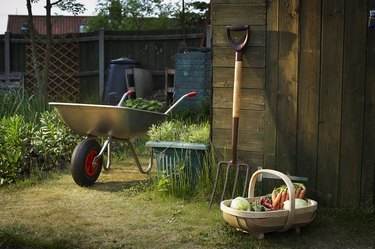
Video of the Day
1) Lettuces
Lettuces are a fine addition to any garden, and they're among the most shade-tolerant vegetables. In fact, in hot climates, some afternoon shade will help keep them from "bolting," or going to seed. Skip the Iceberg-style varieties that form tight heads, and plant leafy lettuces instead. If you have beds filled with full-shade flowers and ornamentals, you can even sow a thick row of lettuces along the sunnier edge, where they'll make an attractive and edible border. Curly lettuces, oak-leaf lettuces and especially red varieties work well in that kind of scenario.
Video of the Day
Read Next: How to Build and Grow a Salad Garden on Your Balcony
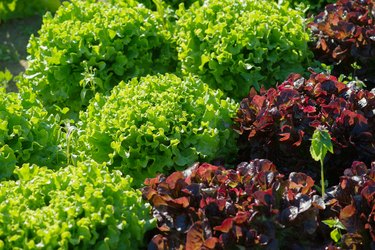
2) Chard
Chard is another shade-tolerant green, and it's as versatile a vegetable as you can grow. The baby leaves are tender enough for salads, the full-grown leaves can be steamed, sauteed or used to enclose your favorite filling, and the juicy stems add bright color to a stir-fry. The amount of sunlight you can give them determines how big they'll grow, but since they're useful and edible at any size it gives you some wiggle room. Chard also lasts obligingly through the summer's heat and into the fall. Choose from white-, yellow- and red-stemmed varieties, or plant a rainbow mix for a splash of color in your shaded areas.
Read Next: Fruits & Vegetables in Season by Month
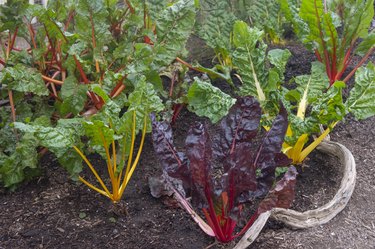
3) Spinach
Spinach shares many characteristics with both lettuces and chard. Like lettuce it's a cool-weather crop that tends to bolt in summer, so it actually benefits from some shade as the weather heats up. Like chard, it can be eaten in salads as baby leaves, or allowed to mature to full size and then cooked. Most gardeners favor bolt-resistant hybrids for planting in full sun, but if you're planting in the shade you can opt for heirloom varieties instead.
Read Next: List of Full Sun Vegetables
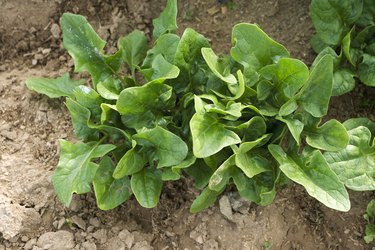
4) Beets
Root vegetables and leafy greens are both relatively tolerant of partial shade, and beets - in their way - are both. Their sweet roots are the most recognizable part of the plant, and they're tasty as a baby vegetable in early summer or as a mature storage vegetable in autumn. Their greens are edible as well, and taste much like chard (a close relative). Most have the signature deep-red color you picture when you think of a beet, but there are also white, gold and variegated ("candy cane") varieties which can be purchased separately or in a mixture. If the greens are your favorite part, "Early Wonder Tall Top" is known for its lavish production.
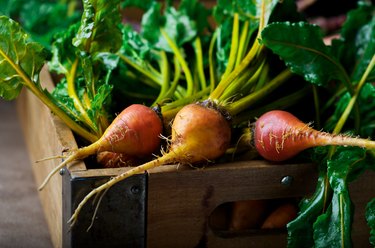
5) Carrots
Like most vegetables, carrots will grow faster and larger with lots of light but they'll also tolerate partial shade (or partial sun, if you're a "look on the bright side" person) quite well. They need a fairly light soil without obstructions in order to grow straight and long, so if your garden is shaded by trees, carrots will struggle to find a home among the roots. Shorter Nantes-style varieties, or heirloom "Parisian" globe carrots, can cope better with obstructions. Carrots are also slow to germinate, so be patient! Even in full sun they can take 2 to 3 weeks to come up.
Read Next: Vegetables That Grow Well in Sand
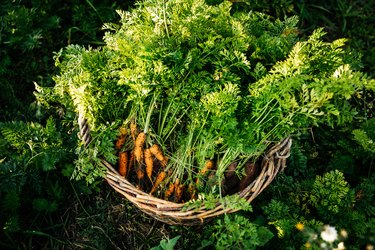
6) Kale
Kale is one of the most reliable vegetables you can grow in your garden. It germinates reliably in the cool of the spring, survives the heat of the summer (especially when you give it some shade) and will continue producing well into the cold weather. In fact, you can harvest it from under the snow! Kale can even be incorporated into otherwise-ornamental beds, with the various curly kales in green and purple, delicate lacy-edged red varieties and darker, pebbled "dinosaur" (lacinato) kale varieties all bringing their own kind of visual interest. Harvest the leaves while they're young and delicate for salads and stir fries, or as mature leaves later in the season.
Read Next: How to Clean Kale With Vinegar
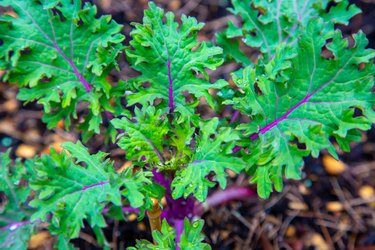
7) Cauliflower
Cauliflower is a marginal performer in partial shade, but for some gardeners it's worth a try. The thing with cauliflower is that it likes cool conditions, and is at its best in areas where you can rely on a long, mild spring or autumn. In short-season climates where spring and fall are brief, it can make sense to try cauliflower in a partially-shaded spot. The shade (especially afternoon shade) can help keep the heads nice and tight as they mature. For best results opt for a short-season variety like Early Snowball, and don't be too disappointed if your crop is minimal. Cauliflower can be tricky, even in favorable conditions.
Read Next: How to Freeze Cauliflower
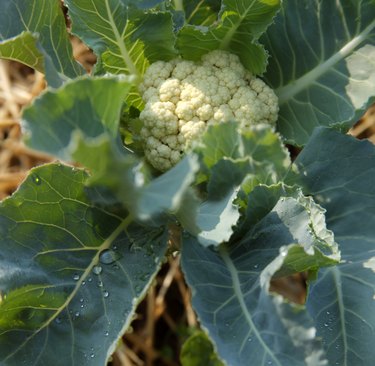
8) Peas
Peas are another cool-weather crop that can flourish in partial shade. Sow them in spring as early as the ground can be worked, and you can already be harvesting edible-pod snow peas or snap peas by the time the rest of your garden is fairly started (shell peas take a bit longer). They'll need a bit of support, in the form of a trellis, to keep them up off of the ground. Peas of all kinds slow to a halt as the summer's heat arrives, so a bit of shade can extend your season. As legumes they enrich the soil with nitrogen, and doubly so if you compost the vines when you pull them.
Read Next: How to Grow Snap Peas

9) Onions and Chives
Onions and chives are reliable producers in partial shade, and they bring a lot to your garden. The narrow spears of chives (and some onions) make a nice edging element in your beds, both onions and chives produce a pretty pompom-like blossom, and of course they're indispensable in the kitchen. They also have the pleasant side benefit of deterring many insect pests. Grow bunching onions for scallions in deeply-shaded areas, or full-sized red, yellow or white onions in spots with a bit more sun. Growing onions from sets (partially-grown bulbs) is quicker than from seed.
Read Next: When to Harvest Green Onions
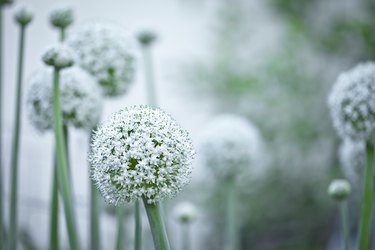
10) Broccoli Raab, aka Rapini
Full-sized broccoli can be iffy in the shade but its cousin, rapini, grows very well in partial sunlight. It produces thick bunches of greens and small, broccoli-like florets, all of which are edible. The flavor is more assertive than broccoli, with a distinct but appealing bitterness (like radicchio) that works well with other bold flavors such as onions, garlic, vinegar, anchovies and hot peppers. Broccoli raab is a cool-weather crop but a quick-growing one, so you can plant in early spring and then again in late summer for an autumn harvest.
Read Next: How to Plant Herbs: Sun & Shade Requirements
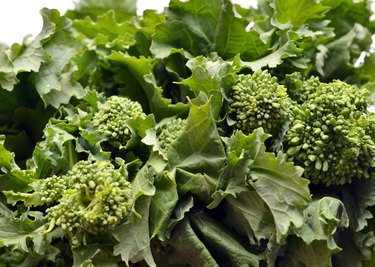
Tips for Gardening in Partial Shade
It's important to have realistic expectations. If most of your potential garden area is in deep shade, it's a stretch to try to grow vegetables there. Leave those spots for shade-tolerant ornamentals like day lilies and hostas, and console yourself with the knowledge that both are edible (use the blossoms in salads, and harvest the earliest hosta shoots as a spring vegetable...if you get them young enough, the plant will send up more).
For areas with partial shade the most important thing you can do is keep a "sunlight journal" throughout the year, to monitor how much light gets through and how long it stays. Eyeball each spot regularly, and mentally judge the amount of light on a scale of 1 to 5 or 1 to 10 (full shade to full sun) throughout the day. The cumulative amount of sun is the important factor: plants will tolerate heavier shade if there are more total hours of sunlight in the day.
Remember, as well, that the sun changes angle and direction as spring gives way to summer and autumn. A spot that's shaded in spring may be in full sun by mid-summer, and you can plan accordingly: put in short-season rapini, peas or radishes in spring, then plant something else later. Use your "sunlight journal" (or a regular garden journal) to note which plants went where, and how they fared. That can help you make better decisions next year.
Finally, think of ways to maximize the light that does reach your garden. A few examples:
- If the offending trees are on your property, have an arborist thin them for you (it will probably make your trees healthier, too).
- Plant short vegetables in front of tall ones, so the tall ones don't create even more shade.
- If there's a convenient wall or fence behind the vegetables, paint it white to reflect the light.
- Cut foil pie plates in half, curl them into a half-cone shape, and use them as reflectors behind individual plants.
None of these steps will entirely make up for a lack of direct sunlight, but they'll all help.